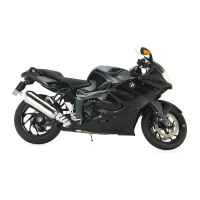safety provided with risky
driving.
Special situations
At an increasing angle, the accel-
eration performance is increas-
ingly limited in accordance with
physical laws. This can result in
delayed acceleration when com-
ing out of very tight curves.
To detect spinning or slipping
away of the rear wheel, the
speeds of the front and
rear wheel are compared. If
implausible values are detected
over a longer period of time, the
ASC function is deactivated for
safety reasons and an ASC fault
is indicated. The condition for a
fault message is the completed
self-diagnosis.
In the following unusual driving
states, the BMW Motorrad ASC
can be automatically deactivated.
Unusual driving conditions:
Driving on the rear wheel
(wheely) for a longer period
with ASC deactivated.
Rear wheel spinning in place
with front brake pulled (burn
out).
Heating up on the main or aux-
iliary stand at idle or with gear
engaged.
The ASC is reactivated by
switching the ignition on and
off and then driving at a speed
above 5 mph (10 km/h).
If the front wheel loses contact
to the ground during extreme
acceleration, the ASC reduces
the engine torque until the front
wheel touches the ground again.
In this case, BMW Motorrad
recommends turning back the
throttle twist grip somewhat to
achieve a stable driving state
again as quickly as possible.
On a slippery surface, the throttle
twist grip should never be sud-
denly turned back completely
without pull the clutch at the
same time. The engine braking
torque can cause the rear wheel
to block, resulting in an unsta-
ble driving state. This case can-
not be controlled by the BWM
Motorrad ASC.
Tire Pressure Control
RDC
with Tire Pressure Control
(TPC/RDC)
OE
Function
A sensor is located in each tire,
which measures the air temper-
ature and the inflation pressure
inside the tire and sends these
values to the control unit.
The sensors are equipped with
a centrifugal controller, which
does not enable the transmis-
sion of the measured values un-
6
87
z
Technology in detail

